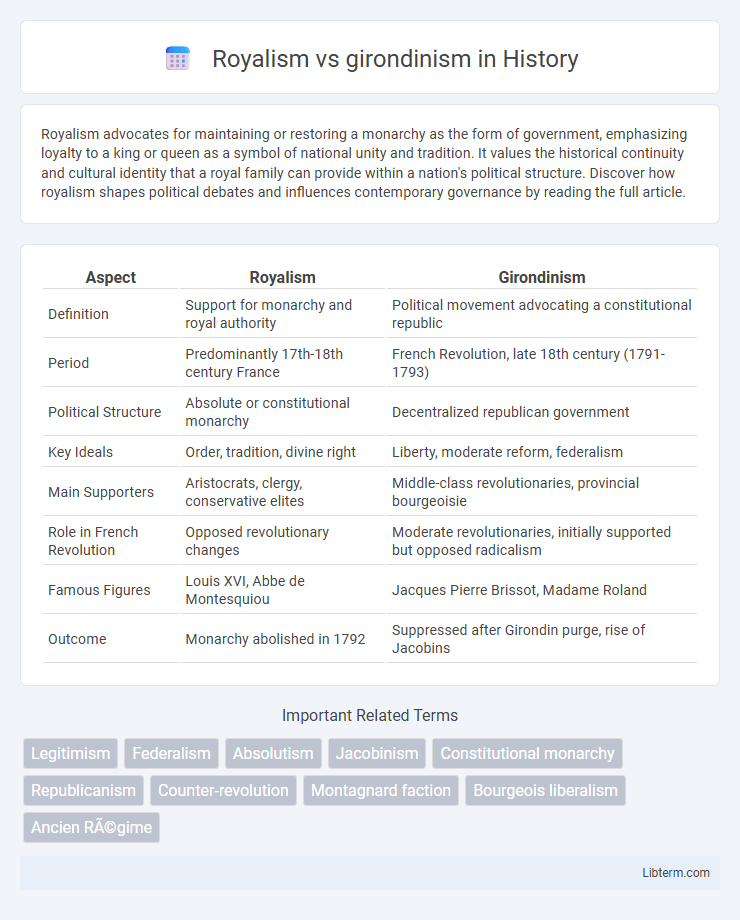Royalism advocates for maintaining or restoring a monarchy as the form of government, emphasizing loyalty to a king or queen as a symbol of national unity and tradition. It values the historical continuity and cultural identity that a royal family can provide within a nation's political structure. Discover how royalism shapes political debates and influences contemporary governance by reading the full article.
Table of Comparison
| Aspect | Royalism | Girondinism |
|---|---|---|
| Definition | Support for monarchy and royal authority | Political movement advocating a constitutional republic |
| Period | Predominantly 17th-18th century France | French Revolution, late 18th century (1791-1793) |
| Political Structure | Absolute or constitutional monarchy | Decentralized republican government |
| Key Ideals | Order, tradition, divine right | Liberty, moderate reform, federalism |
| Main Supporters | Aristocrats, clergy, conservative elites | Middle-class revolutionaries, provincial bourgeoisie |
| Role in French Revolution | Opposed revolutionary changes | Moderate revolutionaries, initially supported but opposed radicalism |
| Famous Figures | Louis XVI, Abbe de Montesquiou | Jacques Pierre Brissot, Madame Roland |
| Outcome | Monarchy abolished in 1792 | Suppressed after Girondin purge, rise of Jacobins |
Understanding Royalism: Core Principles and Ideals
Royalism centers on the belief in a hereditary monarchy as the legitimate source of political authority, emphasizing loyalty to the crown and preservation of traditional social hierarchies. It advocates for a centralized government led by a monarch who embodies national unity and stability, often supporting divine right or hereditary succession as the basis for rule. Royalists prioritize stability, continuity, and the maintenance of established institutions, contrasting sharply with the Girondins' republican and federalist ideals during the French Revolution.
The Emergence of Girondinism in Revolutionary France
The emergence of Girondinism in Revolutionary France marked a critical shift towards moderate republicanism and federalism, contrasting sharply with Royalism which upheld monarchical authority and aristocratic privilege. Girondins advocated for the abolition of the absolute monarchy and promoted constitutional government, emphasizing individual liberties and economic liberalism in response to revolutionary demands. Their rise highlighted the ideological conflict during the French Revolution between preserving traditional royal power and advancing democratic reforms.
Historical Origins: Monarchy vs. Republicanism
Royalism emerged from the historical origins of monarchy, advocating for a centralized sovereign authority rooted in divine right and hereditary succession, prominently seen in pre-Revolutionary France. Girondinism developed during the French Revolution, embodying early republicanism that emphasized representative government, civic rights, and opposition to absolute monarchy. The fundamental conflict between Royalism and Girondinism revolves around the legitimacy of monarchical power versus the establishment of a republic based on popular sovereignty.
Key Figures in Royalism and Girondinism
Royalism was prominently led by figures such as King Louis XVI and the Count of Artois, who championed the preservation of monarchical authority and traditional hierarchical structures. Girondinism featured leaders like Jacques Pierre Brissot and Pierre Victurnien Vergniaud, advocates of moderate republicanism aiming to balance revolutionary change with constitutional governance. These key figures embodied the ideological divide, with Royalists supporting absolute monarchy and Girondins pushing for a liberal yet controlled republic during the French Revolution.
Political Goals: Contrasts and Clashes
Royalism sought to preserve the monarchy and traditional hierarchical structures, emphasizing the divine right of kings and centralized authority. Girondinism advocated for a republican government with representative democracy, promoting federalism and limiting executive power to protect individual freedoms. These conflicting political goals sparked intense clashes, as Royalists resisted revolutionary changes while Girondins pushed for constitutional reforms and broader political participation.
Social Class Support for Royalists and Girondins
Royalists primarily drew support from the nobility, clergy, and conservative rural landowners who favored maintaining traditional hierarchical structures and monarchical authority. Girondins garnered backing mainly from the middle and upper-middle classes, including wealthy merchants, professionals, and provincial bourgeoisie advocating for constitutional monarchy and economic liberalism. This class distinction underscored the ideological divide, with Royalists defending aristocratic privilege while Girondins represented emerging capitalist and bourgeois interests.
Policies on Religion and the Church
Royalism advocated for maintaining the Catholic Church's traditional power and influence, supporting the monarchy's role as the church's protector in France. Girondinism promoted secularization, endorsing the reduction of the Church's political authority and advocating for religious freedom while opposing clerical privileges. The Girondins aimed to separate church and state, challenging the Catholic Church's dominant status upheld by Royalists.
Economic Visions: Royalist vs. Girondin Approaches
Royalists favored an economic system maintaining traditional privileges of the aristocracy, supporting mercantilism, state control of key industries, and protectionist policies to benefit the monarchy and established elites. Girondins advocated for liberal economic reforms including free trade, reduction of guild restrictions, and promotion of agricultural and industrial innovation to stimulate market growth and individual entrepreneurship. These opposing economic visions reflected deeper political conflicts over centralization of power versus decentralized economic freedoms during the French Revolution era.
Impact on the French Revolution’s Trajectory
Royalism's insistence on preserving the monarchy aimed to maintain traditional power structures, ultimately fueling counter-revolutionary sentiments and prolonging internal conflicts during the French Revolution. Girondinism promoted a moderate republicanism that sought to balance revolutionary ideals with political stability, influencing legislative reforms and shaping early revolutionary governance. The clash between Royalist conservatism and Girondin liberalism significantly determined the revolution's trajectory by intensifying factional divides and steering France toward radicalization and the eventual establishment of the Republic.
Legacy and Influence in Modern Political Thought
Royalism's legacy persists in constitutional monarchies that balance traditional authority with democratic governance, influencing debates on the role of monarchy in modern states. Girondinism inspired liberal republican ideals emphasizing decentralized power, individual rights, and federalism, shaping contemporary democratic institutions. The interplay between these ideologies informs ongoing discussions about sovereignty, governance structures, and citizens' rights in political theory.
Royalism Infographic

 libterm.com
libterm.com